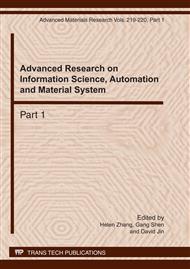[1]
Tong RM. A control engineering review of fuzzy systems. Automatica, 13(1977), 559-568.
Google Scholar
[2]
T.Takagi & M.Sugeno, Fuzzy identification of systems and its applications to modeling and control. IEEE Trans. Syst.,Man, Cybern., SMC-15(1985),116-132.
DOI: 10.1109/tsmc.1985.6313399
Google Scholar
[3]
Kazuo Tanaka, Takayuki Ikeda, etc. Wang, Fuzzy Regulators and Fuzzy Observers: Relaxed Stability Conditions and LMI-Based Designs. IEEE Trans. Fuzzy Syst., Vol. 6(1998), 250-265.
DOI: 10.1109/91.669023
Google Scholar
[4]
Thierry Marie Guerra & Laurent Vermeiren. LMI-based relaxed nonquadratic stabilization conditions for nonlinear systems in the Takagi–Sugeno's form. IEEE Trans. Syst., Man, Cybern. B, Cybern, Vol.40 (2004), 823-829.
DOI: 10.1016/j.automatica.2003.12.014
Google Scholar
[5]
E.Kim & H.Lee. New approaches to relaxed quadratic stability condition of fuzzy control systems. IEEE Trans. Fuzzy Syst., Vol.8 (2000), 523-534.
DOI: 10.1109/91.873576
Google Scholar
[6]
M.C. M.Teixeira, E. Assuncao, & R. G. Avellar. On relaxed LMI based designs for fuzzy regulators and fuzzy observors. IEEE Trans. Fuzzy Syst., Vol.11 (2003), 613-623.
DOI: 10.1109/tfuzz.2003.817840
Google Scholar
[7]
C.-T. Pang & S.-M. Guu. Sufficient conditions for the stability of linear Takagi-Sugeno free fuzzy systems. IEEE Trans. Fuzzy Syst., Vol.11 (2003), 695-700.
DOI: 10.1109/tfuzz.2003.817859
Google Scholar
[8]
Weiss, L., & Infante, E.F. Finite time stability under perturbing forces and on product spaces. IEEE Transactions on Automatic Control, Vol.12 (1967), 54-59.
DOI: 10.1109/tac.1967.1098483
Google Scholar
[9]
F. Amato, b M. Ariola, & P. Dorato. Finite-time control of linear systems subject to parametric uncertainties and disturbances. Automatica, Vol.37 (2001), 1459-1463.
DOI: 10.1016/s0005-1098(01)00087-5
Google Scholar
[10]
Francesco Amato & Marco Ariola. Finite-Time Control of Discrete-Time Linear Systems. IEEE Transactions on Automatic Control, Vol.50 (2005), 724-729.
DOI: 10.1109/tac.2005.847042
Google Scholar
[11]
Xin Daoyi & Liu Yungang. Finite-time stability analysis and control design of nonlinear systems. Journal of Shandong Universituy, Vol.37 (2007), 24-30.
Google Scholar
[12]
Francesco Amato, Roberto Ambrosinob, Marco Ariola, Carlo Cosentino. Finite-time stability of linear time-varying systems with jumps. Automatica, Vol.45(2009), 1354-1358.
DOI: 10.1016/j.automatica.2008.12.016
Google Scholar


